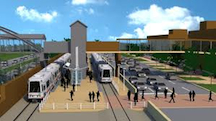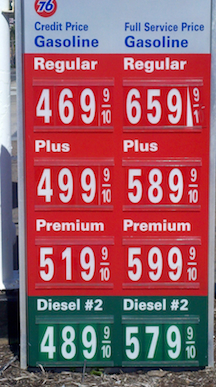By John Addison (6/4/12)
Public Transportation Relieves Gridlock in Cities
Public transportation ridership reached a rate of 10.8 billion rides per year, as Americans took 2.7 billion trips in the first quarter 2012, an increase of 5.0% over the first quarter 2011, according to a report released today by the American Public Transportation Association (APTA). This was the fifth consecutive quarter of U.S. public transit ridership increase.
Transit is valuable for everyone who uses it to commute to, from, and within cities. Public transportation enables millions to go to college without cars and then continue to live car free. Transit also keeps millions of cars off the roads, so that those who drive can get to work on time, instead of losing hours in gridlock.
With gasoline prices soaring over $4 per gallon, even those who own cars are using more transit for commuting, when in cities, and on vacation. A number of U.S. cities are reporting record ridership including:
- Ann Arbor, MI
- Boston, MA
- Charlotte, NC
- Fort Myers, FL
- Indianapolis, IN
- Ithaca, NY
- New York, NY
- Oakland, CA
- Olympia, WA
- San Diego, CA
- Tampa, FL.
“As we look for positive signs that the economy is recovering, it’s great to see that we are having record ridership at public transit systems throughout the country. In some regions of our nation, the local economy is rebounding and people are commuting to their new jobs by using public transportation,” said APTA President and CEO Michael Melaniphy, noting that nearly 60 percent of trips taken on public transit are for work commutes.
Transit combined with car sharing allows more single people to live car free and more households to need fewer cars. Technology makes it easy for people to use Google Maps to compare driving time with transit, pick the best transit route even when combining rail and bus, check bus realtime arrival, and reserve a shared car or ride. Technology is also making the transit systems more efficient.
High Growth Cities for Rail and Bus Transit
 Nationally, light rail (modern streetcars, trolleys, and heritage trolleys) ridership increased 6.7 percent in the first quarter of 2012. Twenty-five of twenty-seven light rail systems reported ridership increases. The ten light rail systems with the highest rates of growth were located in the following cities:
Nationally, light rail (modern streetcars, trolleys, and heritage trolleys) ridership increased 6.7 percent in the first quarter of 2012. Twenty-five of twenty-seven light rail systems reported ridership increases. The ten light rail systems with the highest rates of growth were located in the following cities:
- Memphis, TN (45.7%)
- Salt Lake City, UT (34.1%)
- Seattle, WA – King County DOT (19.4%)
- Boston, MA (12.6%)
- Cleveland, OH (10.7%)
- Houston, TX (10.3%)
- Seattle, WA – Sound Transit (10.3%)
- Los Angeles, CA (9.9%)
- Sacramento, CA (8.5%)
- St. Louis, MO (8.2%)
Fourteen out of fifteen heavy rail heavy rail (subways and elevated trains) systems reported ridership increases. Overall, heavy rail ridership increased by 5.5 percent nationwide. The ten heavy rail systems with the highest first quarter increases in ridership were in the following cities:
- Cleveland, OH (12.2%)
- San Francisco, CA (9.7%)
- Chicago, IL (8.9%)
- Baltimore, MD (7.8%)
- Boston, MA (6.4%)
- Jersey City, NJ (6.1%)
- New York, NY – MTA New York City Transit (5.6%)
- Lindenwold, NJ (4.7%)
- New York, NY – MTA Staten Island Railway (4.5%)
- Miami, FL (4.2%)
Nationally, commuter rail ridership increased by 3.9 percent in the first three months of 2012 with twenty-two of twenty-seven commuter rail systems reporting ridership increases. Top commuter rail growth:
- Anchorage, AK (43.8%)
- Oceanside, CA (19.2%)
- San Carlos, CA (15.0%)
- Portland, OR (11.1%)
- Seattle, WA (10.8%
- New Haven, CT (9.7%)
- Stockton, CA (9.4%)
- Los Angeles, CA (8.9%)
- Salt Lake City, UT (8.5%)
- Nashville, TN (8.4%)
Large bus systems reported an increase of 4.6 percent nationally. Bus systems in the following cities showed the top ten increases:
- Saint Louis, MO (15.6%)
- Dallas, TX (11.9%)
- Arlington Heights, IL (11.1%)
- Boston, MA (10.6%)
- Oakland, CA (10.5%)
- Ft. Lauderdale, FL (8.7%)
- Newark, NJ (8.0%)
- San Antonio, TX (8.0%)
- Washington, DC (7.9%)
- Cleveland, OH (7.8%)
Bus systems in urbanized areas with populations of two million or more grew at 4.5 percent. Growing at an even higher rate of 5.1 percent were bus systems in urbanized areas with populations of 500,000 to just under two million.
Will Congress Kill Transit?
 The success of public transit is one reason that oil use peaked in the United States over six years ago. We now use only 18.3 million barrels of oil daily to make gasoline, diesel, jet fuel, etc., down from 21 million barrels. Transit takes people out of gas guzzling SUVs and into efficient hybrid-electric and natural gas buses and into light-rail that uses locally generated electricity.
The success of public transit is one reason that oil use peaked in the United States over six years ago. We now use only 18.3 million barrels of oil daily to make gasoline, diesel, jet fuel, etc., down from 21 million barrels. Transit takes people out of gas guzzling SUVs and into efficient hybrid-electric and natural gas buses and into light-rail that uses locally generated electricity.
In the United States transportation is heavily subsidized. Gasoline costs half of its real cost, as any visitor to Europe notices. Highways are maintained and widened mostly with funds from income tax. Transit covers less than 30 percent of its cost from fares.
Oil companies are fighting back as transit hurts plans for more offshore drilling, XL pipeline, and record profits from gasoline sales. Members of congress that support Big Oil and “drill baby drill” are trying to kill transit. “As Congress is negotiating a federal surface transportation bill that is now more than 2 1/2 years overdue, our federal representatives need to act before the June 30 deadline to ensure that public transportation systems will be able to meet the growing demand,” said Melaniphy. “It’s obvious from the surge in public transit ridership in the first quarter that Americans need and want public transportation.”
